
The chemistry of isatins a review from 1975 to 1999
.pdf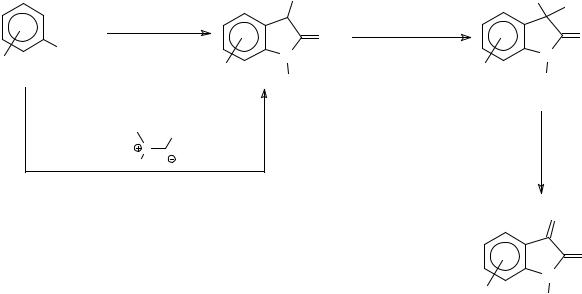
Please use CPS: orgchem/0010004 in any reference to this article
11
oxindole derivative can be synthesized via a N-chloroaniline intermediate, which further reacts with a methylthioacetate ester to furnish an azasulfonium salt (Method 1, Scheme 10). In the case of electron donating groups that destabilize the N-chloro intermediate, and thus give diminished yields of the azasulfonium salt, a second method of generetion of this salt, by reaction of the chlorosulfonium salt with an appropriate aniline (Method 2, Scheme 10), gives better yields of the 3-methylthio-2-oxindoles.
Various methodologies have been devised for the conversion of these oxindoles to isatins. Reaction with N-chlorosuccinimide generates the unstable 3-chloro-3-methylthio-2- oxindoles, which were hydrolysed to isatins in the presence of red mercuric oxide and BF3.Et2O in aqueous THF. Hydrolysis in the absence of these reagents gave a mixture of the isatn and the 3,3-dimethylthio-2-oxindole ketal42. Air oxidation of methylthio-oxindoles in the presence of a base in aqueous methanol also resulted in formation of the respective isatin, although over oxidation, generating anthranilic acid derivatives, was a problem and generated anthranilic acid derivatives 47 (Scheme 10).
|
|
Method 1 |
|
SMe |
|
|
Cl |
SMe |
|
|
|
|
|
|
|
|
|||
|
|
|
|
|
|
|
|
|
|
|
|
1) tBuOCl |
|
O |
N-Chlorosuccinimide |
|
|
O |
|
|
|
2) MeSCH2CO2Et |
|
|
|
||||
|
NH2 |
|
|
|
|
||||
|
|
N |
|
|
|
N |
|||
X |
3) Et N; 4) H O+ |
|
|
|
|
||||
|
3 |
3 |
X |
H |
|
X |
|
H |
|
|
|
|
|
|
|
||||
|
|
|
|
|
|
|
|
||
|
|
Method 2 |
|
|
|
|
|
|
|
|
|
1) |
CO2Et |
|
|
|
|
|
HgO/BF3 or |
|
|
S |
|
|
|
|
|
||
|
|
Cl |
Cl |
|
|
|
|
|
H2O/THF/∆ |
|
|
2) Et3N; 3) H3O+ |
|
|
|
|
|
|
|
O
O
N
X H
Scheme 10
This article is available from: http://preprint.chemweb.com/orgchem/0010004 Uploaded 17 October 2000 at 14:44 GMT

Please use CPS: orgchem/0010004 in any reference to this article
12
Recently Wright and co-workers have described a modified Gassman oxindole synthesis. They point out the problem associated with the preparation of the chlorosulfonium salt (reagent for Method 2) from chlorine gas and ethyl methylthioacetate, and demonstrated a modified procedure that makes use of a sulfoxide as a synthetic equivalent of a sulfenyl halide48 (Scheme 11). The Gassman procedure can also be applied to N-alkylanilines43.
|
|
|
|
|
SMe |
|
CO2Et |
Cl2, CH2Cl2 |
|
CO2Et |
|||
S |
O |
|||||
S |
-78 |
o |
C |
|||
Cl |
N |
|||||
|
|
|||||
|
|
|
|
|
R |
|
CO2Et |
(COCl) , CH Cl |
2 |
|
|||
S |
2 |
|
2 |
|
||
-78 oC |
|
|
||||
O |
|
|
||||
|
|
|
|
|
||
Scheme 11
2.6 Metalation of anilide derivatives
A more recent method for the synthesis of isatins is based upon the directed ortho- metalation (DoM) of N-pivaloyl- and N-(t-butoxycarbonyl)-anilines. The corresponding dianions are treated with diethyl oxalate and the isatins are obtained after deprotection and
cyclisation of the intermediate α -ketoesters. This method has the advantage of being regioselective for the synthesis of 4-substituted isatins from meta-substituted anilines where the substituent is a metalation directing group (e.g. OMe) 49 (Scheme 12).
This article is available from: http://preprint.chemweb.com/orgchem/0010004 Uploaded 17 October 2000 at 14:44 GMT
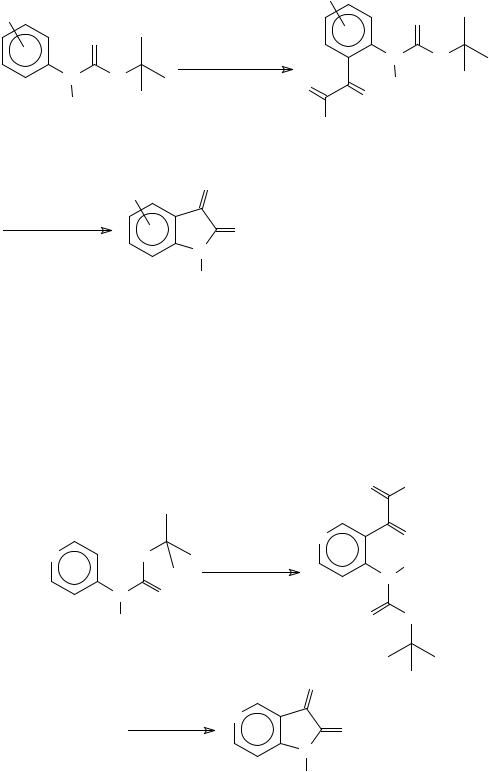
Please use CPS: orgchem/0010004 in any reference to this article
13
R |
|
|
R |
|
|
O |
|
O |
|
|
N O |
N O |
1) n-BuLi, THF; |
|
|
2) diethyl oxalate |
O |
O H |
|
H |
|
||
|
|
OEt |
|
|
|
|
|
R |
O |
|
|
|
|
|
|
HCl 12N/THF/∆ |
O |
|
|
(79-89%) |
N |
|
|
|
|
|
H
Scheme 12
The synthesis of 5-azaisatin was realized by ortho-lithiation of the 4-aminopyridine t- butylcarbamate followed by reaction with an excess of diethyl oxalate. Heating the glyoxylic ester under vaccum gave 5-azaisatin50 (Scheme 13).
|
|
|
O |
OEt |
|
N |
O |
|
N |
O |
|
BuLi |
|
H |
|||
|
|
N |
|||
N |
O |
(CO2Et) |
|||
|
|
||||
H |
|
|
O |
O |
|
|
|
|
O |
|
|
|
∆ |
N |
O |
|
|
|
|
|
|
||
|
|
|
N |
|
|
|
|
|
H |
|
|
|
|
Scheme 13 |
|
|
This article is available from: http://preprint.chemweb.com/orgchem/0010004 Uploaded 17 October 2000 at 14:44 GMT

Please use CPS: orgchem/0010004 in any reference to this article
14
Recently, a metal-halogen exchange method was described for the synthesis of isatins by lithiation of ortho-bromophenylureas, carbonylation and subsequent intramolecular cyclisation to give the desired products in 71-79% yield51 (Scheme 14).
|
|
|
|
O |
|
|
R |
Br O |
|
R |
Li |
O |
|
1) MeLi, 0 oC |
R |
|||||
|
||||||
|
|
2) t-BuLi, 0 oC |
|
|
O |
|
|
N N |
3) CO |
Li |
N |
N |
|
|
|
4) H O+ |
|
|||
|
H |
3 |
|
|
H |
|
|
|
O |
N |
|||
|
|
|
Scheme 14
2.7 Miscellaneous procedures
These previously discussed methodologies are the most general and/or most commonly employed procedures for the synthesis of isatins. Other methodologies have been employed, but they are less general and some of them lead to the desired product in low yield.
Parrick and co-workers developed a synthetic methodology for isatins from indoles, using N-bromosuccinimide to promote their oxidation to yield 3,3-dibromooxindoles which were subsequently hydrolysed to the desired isatins52,53. By using this method it was possible to obtain 7-azaisatin from 7-azaindole, although in low yield. This isatin is more readily obtained by oxidation of the indolic compound using chromic anhydride in acetic acid54 and this methodology can also be applied to the oxidation of 5-azaindole to yield 5-azaisatin55.
In an alternative methodology, 4- and 6-substituted-2-oxindoles, obtained from o- nitroarylmalonates, were converted to 3,3-dibromooxindoles by reaction with pyridinium perbromide. These intermediates were hydrolyzed to the corresponding isatins. This method, although limited to substrates with moderate to strongly electron withdrawing groups
This article is available from: http://preprint.chemweb.com/orgchem/0010004 Uploaded 17 October 2000 at 14:44 GMT

Please use CPS: orgchem/0010004 in any reference to this article
15
(otherwise bromination of the aromatic ring occurs), suits well for the regioselective synthesis of 4- and 6-substituted isatins, such as 6-benzoylisatin56 (Scheme 15).
|
R1 |
|
|
R1 |
CO2Et |
|
R2 |
Cl |
(EtO C) CH |
R2 |
|
Sn, HCl |
|
|
|
2 2 |
2 |
|
CO2Et |
|
|
|
NaH |
|
|
|
|
|
|
|
|
|
|
|
R3 |
NO2 |
|
|
R3 |
NO2 |
|
|
R1 |
R1 |
Br |
Br |
R1 |
O |
R2 |
|
R2 |
|
R2 |
|
|
Py.HBr.Br2 |
|
|
|
|||
|
|
|
O |
H2O/MeOH |
O |
|
|
O |
|
|
|
||
R3 |
N |
R3 |
|
N |
R3 |
N |
|
H |
|
|
H |
|
H |
|
|
|
|
|
26-75% |
|
Scheme 15
Nitrones and dichloroketene react to furnish 3,3-dichlorooxindoles, which upon hydrolysis, lead to the desired isatins57. N-Aryl-benzoisatins can also be obtained from napthoquinones and anilines as a result of oxidation of the cyclic anils 58 (Scheme 16).
O
Br
O O
OH
1) PhNH2
2) H2O O
N
O
Scheme 16
1,4-Dimethylisatin can be obtained from air oxidation and hydrolysis of the cyclocondensation product of aryliminoacylhydrazones59 (Scheme 17).
This article is available from: http://preprint.chemweb.com/orgchem/0010004 Uploaded 17 October 2000 at 14:44 GMT
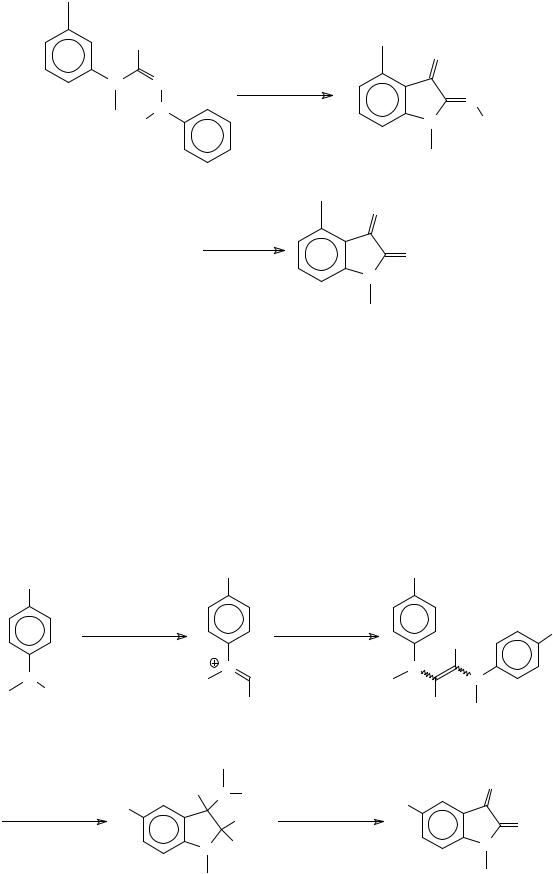
Please use CPS: orgchem/0010004 in any reference to this article
16
CHO
N N
H N
|
O |
|
1. BF3.Et2O |
|
N |
or PPA |
N |
|
2. Air |
NHΦ |
|
O |
|
H2O |
O |
|
(76%) |
||
|
N
Scheme 17
Meth-Cohn and co-workers have observed that the treatment of 1,2-bis (N- methylanilino)-1,2-dichloroethanes, obtained by the dimerisation of the Vilsmeier reagents prepared from N-methylformanilides in POCl3 using a tertiary amine, with an eletrophilic species yielded isatins in 11 to 79% after hydrolysis. The best yields were observed when bromine was used as the electrophilic species60 (Scheme 18).
X |
X |
X |
|
|
|
POCl3 |
Hünig's |
X |
|
base |
Cl |
N CHO |
N |
N |
Cl |
N |
|
|
Cl |
|
Cl |
N Ar |
|
O |
|
|
X |
||
1) Br2 |
X |
Br |
H O |
|
2) H2O |
|
2 |
O |
|
|
|
|
||
N |
Cl |
|
N |
|
|
|
Scheme 18
This article is available from: http://preprint.chemweb.com/orgchem/0010004 Uploaded 17 October 2000 at 14:44 GMT
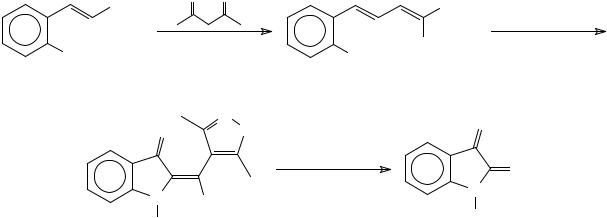
Please use CPS: orgchem/0010004 in any reference to this article
17
Isatin is formed from 2-nitrocinnamaldehyde through the sequence shown below61
(Scheme 19):
CHO
O O
COMe
|
|
NH2OH.HCl |
|
NO2 |
COMe |
MeCN |
|
NO2 |
|
||
|
N |
O |
|
O |
O |
||
|
|||
|
CrO3 |
O |
|
|
|
||
N |
Cl |
N |
|
H |
|||
H |
|
||
|
|
Scheme 19
1-Napthlylamine, when reacted with 1,2,4-triazin-5-ones in acetic acid, gives benzo[e]indole-2,3-dione in 71 to 81% yields, but both aniline and 1-methylaniline fail to furnish the corresponding isatins62.
A de novo isatin synthesis based upon a palladium catalysed double carbonylation of ortho-haloacetanilides in the presence of Et2NH to yield the corresponding glyoxylic acid amide was reported by Yamamoto and co-workers63. Hydrolysis of this amide yielded the respective isatin (Scheme 20).
This article is available from: http://preprint.chemweb.com/orgchem/0010004 Uploaded 17 October 2000 at 14:44 GMT
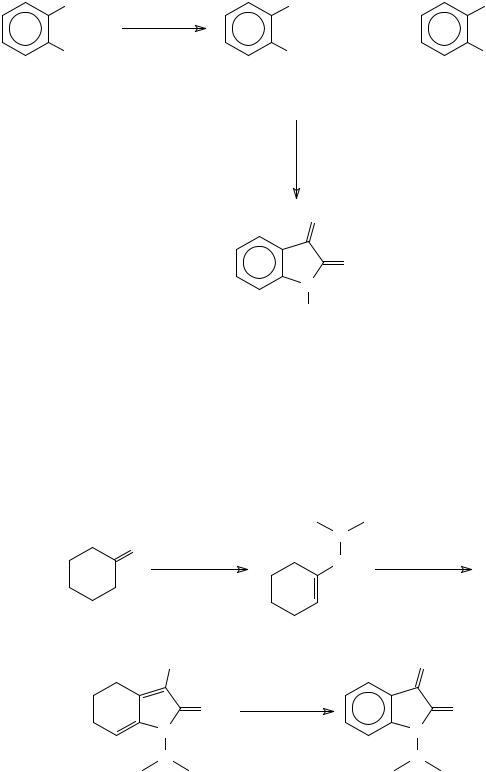
Please use CPS: orgchem/0010004 in any reference to this article
18
X |
CO |
COCONEt2 |
CONEt2 |
|
|
|
+ |
||
|
Et2NH |
|
||
NHAc |
NHAc |
NHAc |
||
Pd |
||||
|
|
|
||
X = Br, I |
|
(30-77%) |
(14-70%) |
3N HCl
O
O
N
H
(93%)
Scheme 20
1-(Dialkylimino)isatins can be prepared from cyclohexanone in three steps, the last involving DDQ oxidative aromatization64 (Scheme 21).
O |
|
N |
|
H2NNMe2 |
NH (COCl)2 |
||
|
OH |
|
O |
O |
DDQ |
O |
|
||
N |
|
N |
N |
|
N |
|
Scheme 21 |
|
This article is available from: http://preprint.chemweb.com/orgchem/0010004 Uploaded 17 October 2000 at 14:44 GMT
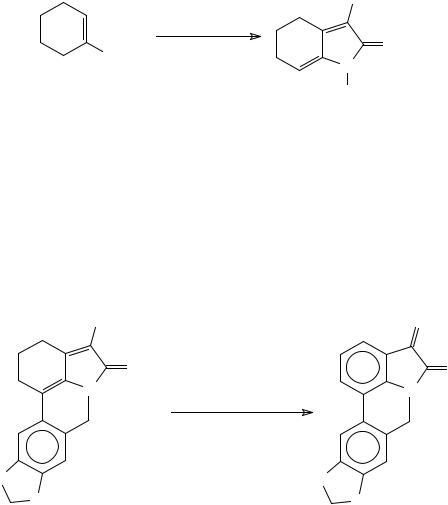
Please use CPS: orgchem/0010004 in any reference to this article
19
Rigby has developed a different approach for the construction of the hydroindolone intermediates65. These compounds were prepared by [1+4] cycloaddition of vinyl isocyanates and isocyanides (Scheme 22).
NHC6H11
DPPA
CO H C6H11NC |
O |
|
|
2 |
N |
|
|
|
H |
|
(84%) |
Scheme 22
The resultant dienamides can be hydrolysed and subsequently oxidised by DDQ to yield isatin derivatives66 (Scheme 23).
NHC6H11 |
|
O |
O |
|
O |
N |
1) (CO2H)2, MeOH |
N |
|
|
|
|
2) DDQ |
|
O |
|
O |
O |
|
O |
Scheme 23
The formation of isatins has been reported during decomposition studies of the structure or reactivity of natural products. In this manner, the attempted epoxidation of rutacridone led to N-methylisatin67 (Scheme 24).
This article is available from: http://preprint.chemweb.com/orgchem/0010004 Uploaded 17 October 2000 at 14:44 GMT
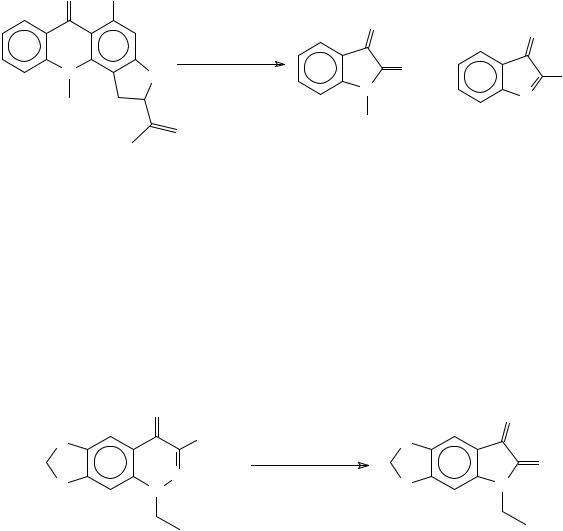
Please use CPS: orgchem/0010004 in any reference to this article
20
O |
OH |
|
|
|
|
|
|
|
O |
O |
|
|
|
|
|
||
N |
|
tBuOOH |
O |
+ |
|
O |
Mo(CO)6 |
||||
OMe |
|||||
|
|
|
N |
N |
|
|
|
|
|
Scheme 24
Isatins are also formed during the photo-oxidation of 5,6-dihydroindoles68, from the oxidation of indoles with thallium (III) trinitrate69 and by electrochemical oxidation of indigo carmine70. 1-Ethyl-5,6-methylenedioxyisatin is obtained in the electrochemical reduction of cinoxacin, an antibacterial agent, in 92% yield71 (Scheme 25).
|
O |
|
|
O |
|
CO2H |
|
|
|
O |
e- |
O |
|
|
|
|
|
O |
|
|
N N |
O2 |
|
|
O |
O |
N |
Scheme 25
3. Reactivity of isatin and derivatives towards electrophiles
3.1 N-alkylation
Many methods have been devised for the N-alkylation of isatins. These derivatives are commonly synthesized from the reaction of the sodium salt of isatin with alkyl halides or sulphates72,73. Various methods for the preparation of this salt have been reported, and include the reaction of isatin with sodium hydride, either in toluene under reflux74 or in DMF75. Other methods include the use of potassium carbonate in DMF76,77 or in acetone78. In the latter case an aldol reaction of the solvent also occurs with the C-3 carbonyl of the isatin derivative.
This article is available from: http://preprint.chemweb.com/orgchem/0010004 Uploaded 17 October 2000 at 14:44 GMT
